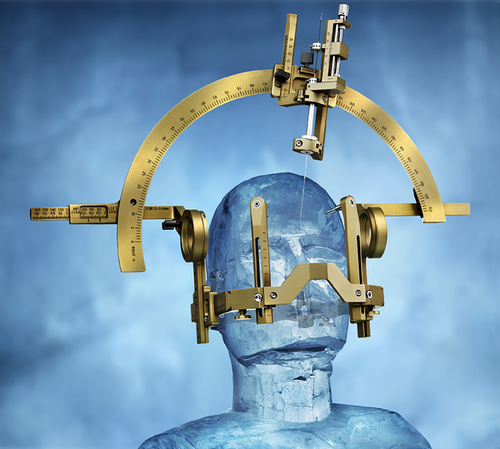Anesthesia for deep brain stimulation in traumatic brain injury-induced hemidystonia
Key Clinical Message
Deep brain stimulation in an awake patient presents several unique challenges to the anesthesiologist. It is important to understand the various stages of the procedure and the complexities of anesthetic management in order to have a successful surgical outcome and provide a safe environment for the patient.
Introduction
Deep brain stimulation (DBS) is a neurosurgical technique aimed at improving “functional” neurologic disorders. To facilitate intraoperative neurophysiologic microelectrode recording (MER) and neurocognitive testing of the eloquent parts of the brain, DBS is commonly performed via an “awake” approach under a local anesthetic and conscious sedation. While a deeper plane of anesthesia can be used during the portion of the procedure not involved in testing, an awake and cooperative patient with fully preserved brain function is essen-tial during MER to ensure accurate lead placement 1, 2.
Case Description
Our case involved a developmentally delayed 24-year old, 80-kg male with traumatic brain injury (TBI) as an infant with resultant post-traumatic stroke, hydrocephalus, and right upper extremity hemidystonia, causing a prominent dystonic flexor position at the elbow. The surgical plan included implantation of intracranial DBS leads in the globus pallidus internus in an attempt to relieve the hemidystonia. A peripheral IV was placed and midazolam 2 mg was administered en route to the OR. Standard ASA monitors were applied along with 2 L/min of oxygen via nasal cannula, while the neurosurgical team prepared for head frame placement. A dexmedetomidine intravenous infusion at 0.5 μg/kg/h was started, and a total of 1.2 μg/kg of fentanyl was administered incrementally for local anesthetic infiltration at the head frame pin sites. During this period, the patient maintained spontaneous ventilation and did not react to local infiltration, pin insertion, or head frame manipulation.
A radial arterial line and second peripheral IV were placed under local and propofol infusion at 100 μg/kg/min. Before MER and neurocognitive testing, propofol was turned off in order to transition to the “awake” segment of the procedure. The patient was able to follow commands under the dexmedetomidine infusion alone. Exceptional quality MER recordings were obtained. Once MER was complete, the propofol infusion was restarted to supplement the dexmedetomidine infusion during surgical site closure. The patient's postoperative course was uneventful, and he was discharged home 2 days after the procedure. At patient's 6-month follow up clinic visit, he had a dramatic reduction in his right upper extremity tremor and had a significant improvement in his ability to perform daily activities.
Discussion
DBS involves the placement of wire electrodes into deep brain nuclei. For movement disorders, these deeper brain structures include the subthalamic nucleus, internal segment of the globus pallidus, and thalamic nucleus ventralis intermedius. Electrical impulses are delivered to these structures with the objective of altering specific neural networks, resulting in a therapeutic effect. The electrodes are then connected to an implanted pacemaker that produces high-frequency stimulations that help ameliorate the clinical manifestations of functional neurologic disorders, while having the added qualities of titratability and reversibility 3.
Targeting specific deep brain structures in DBS surgery is based on stereotactic principles that use advanced brain imaging and atlases. The surgical trajectory is guided by stereotactic platforms, which may be framed or frameless. The deep brain nuclei targets are verified by their electrophysiological signature using intraoperative neurophysiologic mapping. This presents several unique challenges to the anesthesiologist: providing patient reassurance and comfort, especially during head frame placement and Burr hole drilling, and maintaining this level of supportive care over a potentially long surgery; ensuring proper positioning to allow for safe and optimal surgical conditions; and maintaining access to the patient's airway while anticipating emergency airway interventions in the event ventilatory compromise occurs under sedation. This is especially important as the head frame system (Fig. 1) can impair access to the airway, making mask ventilation problematic. Patient cooperation, providing an anesthetic technique that will minimally interfere with MER, and maintaining spontaneous ventilation and airway patency are crucial to a successful outcome in these cases. Finally, an appropriate blood pressure should be maintained in order to minimize the risk of intracranial bleeding, a well-known complication in DBS procedures 4. All of these challenges are magnified in the younger or developmentally delayed patient population.

The anesthetic management of an awake craniotomy has changed over the past 20 years in an attempt to address the aforementioned challenges. Currently, the most popular technique is the “asleep-awake-asleep” technique. This employs a heavier sedation or general anesthesia during the initial stages, alternating with consciousness using rapid-onset medications with a short duration of action during brain mapping and neurocognitive testing 2. After mapping is complete, deep sedation or general anesthesia can be reestablished for surgical closure and removal of the pins. Propofol, remifentanil, and dexmedetomidine are some of the anesthetics that have been used for awake craniotomy (Table 1). While propofol and remifentanil are short-acting, propofol can attenuate MER and remifentanil may cause muscle rigidity. Both drugs can result in respiratory depression, so they must be titrated carefully. While high doses of dexmedetomidine can abolish MER, low dose infusion rates (0.3–0.6 μg/kg/h) usually preserve MER integrity, while also providing analgesia and sedation without respiratory depression 1. The α-2A receptors in the locus ceruleus are responsible for the sedative, analgesic, and sympatholytic effects of dexmedetomidine. This specific effect over α-2A receptors may allow cortical neurons to continue functioning upon stimulation in contrast to propofol or even barbiturates that produce generalized neuronal hyperpolarization.
| Anesthetic agent | Advantages | Disadvantages | Effects on MER for DBS |
|---|---|---|---|
| Benzodiazepines |
Sedation Anxiolysis Amnestic |
May induce dyskinesia Potentiate ventilatory depressant effects of narcotics Depresses swallowing reflex Decreases upper airway activity |
Abolishes MER |
| Dexmedetomidine |
Cooperative” sedation Easily arousable Analgesia Minimal respiratory depressant effects Hemodynamic stability |
Bradycardia Hypotension |
Low-dose infusion rates: minimal effects on MER High-dose infusion rates: suppress MER signals |
| Ketamine |
Analgesia Minimal respiratory depressant effects |
Hypersalivation Emesis Transient myoclonus Hyperreflexia May increase ICP Emergence delirium Hypertension |
Minimal effects on MER |
| Narcotics |
Sedation Analgesia Cough suppression Remifentanil is short acting |
Respiratory depression Rigidity Airway obstruction Nausea/vomiting Potentially increases ICP Pruritus Suppression of tremors |
Minimal effects on MER |
| Propofol |
Sedation Short duration of action Antiemetic properties Widely used Predictable emergence profile |
Respiratory depression Pain on injection Tendency to cause sneezing Abolishes tremors Induces dyskinesia |
Attenuation of MER |
In a recent case study, 6 pediatric patients with severe dystonia successfully underwent DBS procedures with the use of low-dose dexmedetomidine as part of the anesthetic technique with unimpaired neuroelectrophysiological signals 5. Since it does not directly affect the activity of subthalamic neurons, dexmedetomidine may be an ideal sedative medication for neurophysiologic monitoring 6. Low-dose dexmedetomidine (0.1–0.4 μg/kg/h) infusion has been shown to produce MER from subthalamic neurons similar to MER during the awake state 7. Additionally, dexmedetomidine use has decreased the intraoperative need for antihypertensive medications used to prevent intracranial hemorrhage 4.
As seen in the presented case, the surgeon was able to perform successful cortical mapping during low-dose dexmedetomidine infusion allowing the patient to follow simple verbal commands. There was no evidence of respiratory depression, and dexmedetomidine also likely decreased the amount of narcotic needed for this stimulating procedure. It has been well-documented in the literature that dexmedetomidine decreases the need for narcotic administration in various surgical procedures. Despite the patient's severe dystonia and developmental delay, he remained a good candidate for DBS via an awake approach. Dexmedetomidine helped facilitate this by decreasing the patient's anxiety and restlessness during the procedure and allowing for an easy transition from sedation to responsiveness.
While DBS is most commonly performed for generalized dystonias, there are few reports in the literature describing DBS for TBI-induced dystonias. Here, we have presented a case of DBS in an awake patient with post-traumatic hemidystonia. Although various anesthetic techniques and combinations of drugs have been described for an awake craniotomy, dexmedetomidine appears to be useful in procedures, involving DBS and neurophysiologic monitoring. As the indications for DBS in the pediatric patient population are expanding and the demand for this procedure increases, the creation and implementation of standardized protocols guiding the complex anesthetic management for these cases would be of value.
Acknowledgments
Approval: The IRB at Children's National Medical Center reviewed this case report and gave permission for the authors to publish the report. In addition, the patient and family were contacted and written permission and consent to publish this case report was obtained.
Conflict of Interest
No conflicts of interest declared.




